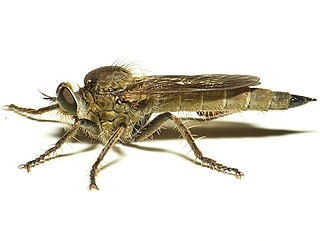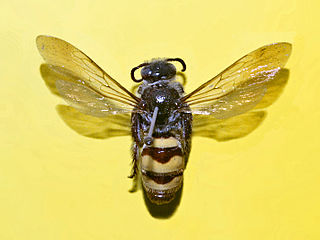
Orb-weaver spiders are members of the spider family Araneidae. They are the most common group of builders of spiral wheel-shaped webs often found in gardens, fields, and forests. The English word "orb" can mean "circular", hence the English name of the group. Araneids have eight similar eyes, hairy or spiny legs, and no stridulating organs.

Nephila is a genus of araneomorph spiders noted for the impressive webs they weave. Nephila consists of numerous species found in warmer regions around the world, although some species formerly included in the genus have been moved to Trichonephila. They are commonly called golden silk orb-weavers, golden orb-weavers, giant wood spiders, or banana spiders.

Nephila pilipes is a species of golden orb-web spider. It resides all over countries in East and Southeast Asia as well as Oceania. It is commonly found in primary and secondary forests and gardens. Females are large and grow to a body size of 30–50 mm, with males growing to 5–6 mm. It is the second largest of the orb-weaving spiders apart from the recently discovered Nephila komaci. The first, second, and fourth pairs of legs of juvenile females have dense hairy brushes, but these brushes disappear as the spider matures.

Philobota stella is a moth of the family Oecophoridae. It is found in Australia, including Tasmania.

Philobota lysizona is a moth of the family Oecophoridae. It is found in Australia.

Philobota partitella is a moth of the family Oecophoridae. It is found in Australia.
Thalassomya is a genus of midges in the non-biting midge family (Chironomidae).

Callerya is a genus of flowering plants in the legume family, Fabaceae. It belongs to the subfamily Faboideae, tribe Wisterieae. It includes 12 species native to the eastern Himalayas, Indochina, southern China and Taiwan, and Peninsular Malaysia. Its species are climbers, generally reaching up to about 1 m (3 ft) tall. The genus has a somewhat complicated taxonomic history; its circumscription was substantially revised in 2019.

Machimus is a genus of flies in the family Asilidae, the robber flies and assassin flies. They can be found nearly worldwide, except in Australia and New Zealand. Most are native to the Palearctic realm and southern Asia.
Apiomerus pilipes, the bee assassin, is an insect that feeds on bees. It is found in South America and reported from Venezuela, Colombia, French Guiana, and Brazil. Like other members of the genus, females of this species have well-developed hind abdominal foliaceous appendages which can be coated with plant-derived resin.

Philobota arabella is a moth of the family Oecophoridae. It is found in the dry grassy native woodlands of Victoria.

Philobota ellenella is a moth of the family Oecophoridae. It is known from the Australian Capital Territory, New South Wales and Victoria.

Dielis is a New World genus of the family Scoliidae, also known as the scoliid wasps.

Coelopa pilipes is a common European species of kelp fly. It was described by A. H. Haliday in 1838. Their appearance differs greatly from that of other Coelopa flies.

Philobota is a genus of concealer moths in the family Oecophoridae erected by Edward Meyrick in 1883. There are more than 200 described species in Philobota. They are found predominantly in Australia.

Dielis pilipes, the hairy-footed scoliid wasp, is a species of scoliid wasp in the family Scoliidae.

Tingena aletis is a species of moth in the family Oecophoridae. It is endemic to New Zealand and has been collected in the vicinity of Arthur's Pass in the South Island. Adults are on the wing in January.

Austrocallerya pilipes, synonym Callerya pilipes, is a species of flowering plant in the family Fabaceae, endemic to Queensland, Australia. It is a robust twining vine, climbing up trees and shrubs. It is known as the northern wistaria.
















